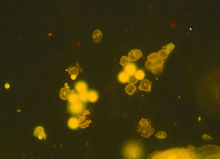Phagocytosis
Phagocytosis (from ancient Greek φαγεῖν phagein , German 'eat' and ancient Greek κύτος cýtos , German 'cavity' ), also Germanized phagocytosis , describes the active uptake of particles (up to smaller cells) into a single eukaryotic cell . Both protists and specialized multicellular cells are capable of phagocytosis. Phagocytosis is a form of endocytosis .

Protists
In unicellular organisms, they can be incorporated with a change in the shape of the cell, for example by enclosing the foreign particles with pseudopodia (pseudopods) or by invagination ( invagination ) or without this through special organelles (transport to the cytostome via the buccal cavity in ciliate animals or by means of the cytopharynx in ciliate animals and some Euglenozoa ). Through phagocytosis, the smuggled objects are enclosed in food vacuoles , and only then does the actual digestion take place.
Mammals

In mammals and in human medicine, the term phagocytosis is mostly related to the uptake of larger particles by specialized cells, the so-called phagocytes , which can move freely in body fluids . Enveloping and destroying invading microorganisms through phagocytosis is an important part of the response of the cellular immune system . In addition, phagocytosis is necessary for the removal of dead ( apoptotic ) cells. In particular, the uptake of pathogenic microorganisms by neutrophilic granulocytes is an important part of the body's immune system . The phagocytes recognize the pathogenic microorganisms by their specific surface structure (for example from simple sugars - not to be confused with antigens). Most cells that promote phagocytosis are phagocytes (cells of the immune system such as macrophages or dendritic cells ). The phagocytosed microorganisms become enclosed in vesicles, which then fuse with the lysosomes and are digested.
Certain pathogens make use of this mechanism in order to be able to penetrate macrophages by means of phagocytosis and multiply there, for example Mycobacterium tuberculosis . A basic distinction is made between two different mechanisms: In the so-called zipper mechanism, the pathogenic microorganism forms cell adhesion molecules that are recognized by the host cell's receptor (e.g. a macrophage) and trigger phagocytosis. The second mechanism is the so-called trigger mechanism. A bacterium injects effector molecules (specific protein mixtures ) into the phagocyte , which cause the host cell to form membrane protuberances and then trigger phagocytosis.
Examples of pathogens are Salmonella enterica and Shigella flexneri . These pathogens are often ingested with spoiled food .
The prerequisite for successful phagocytosis is specific recognition and binding by receptors on the cell surface. Foreign bodies such as bacteria or fungi are removed by phagocytes at the focus of the infection. Phagocytosis also plays a key role in initiating the adaptive immune response by promoting the release of pro-inflammatory cytokines. The binding of phagocytic targets attracts lymphoid cells. In addition, professional antigen-presenting cells can present the antigen-specific lymphocytes with the antigen peptides that they generate from the ingested particles by limited proteolysis and thus activate them.
Fibroblasts, epithelial cells and endothelial cells are unable to eat microbes. However, they can absorb apoptotic cell bodies and thus contribute to the turnover of the billions of cells that are sorted out daily. If antigens that expose danger signals are phagocytosed, they trigger an inflammatory reaction. In contrast to this, apoptotic cells emit anti-inflammatory signals during their phagocytosis, which prevent further damage to the tissue. The large number of different phagocytes and eating targets and the complexity of their interactions make it unlikely that the phagocytosis processes take place in the same way everywhere. Phagocytosis is mediated through receptors. Since the nature of the particles ingested by phagocytosis is very broad, there is a need for the existence of numerous different receptors for this process. In this context, the receptors for pattern recognition, for opsonins and for dead and dying cells are important.
See also
Individual evidence
- ^ Rudolf Röttger: Dictionary of Protozoology In: Protozoological Monographs, Vol. 2, 2001, pp. 170–171, ISBN 3-8265-8599-2 .
- ↑ H. Hahn et al. a .: Medical microbiology and infectious diseases. Springer, 2008, p. 91, ISBN 3-540-46359-3 , online here .
- ↑ Ronald S. Flannagan, Valentin Jaumouill´e, Sergio Grinstein: The cell biology of phagocytosis. In: Annual Review of Pathology: Mechanisms of Disease . Volume 7, 2012, pp. 61-98 doi : 10.1146 / annurev-pathol-011811-132445 .
